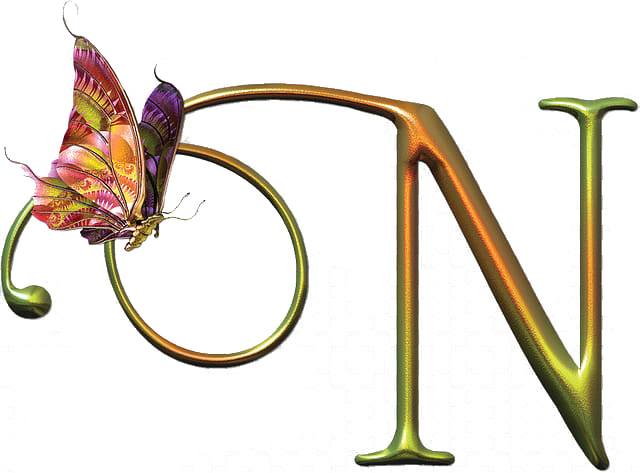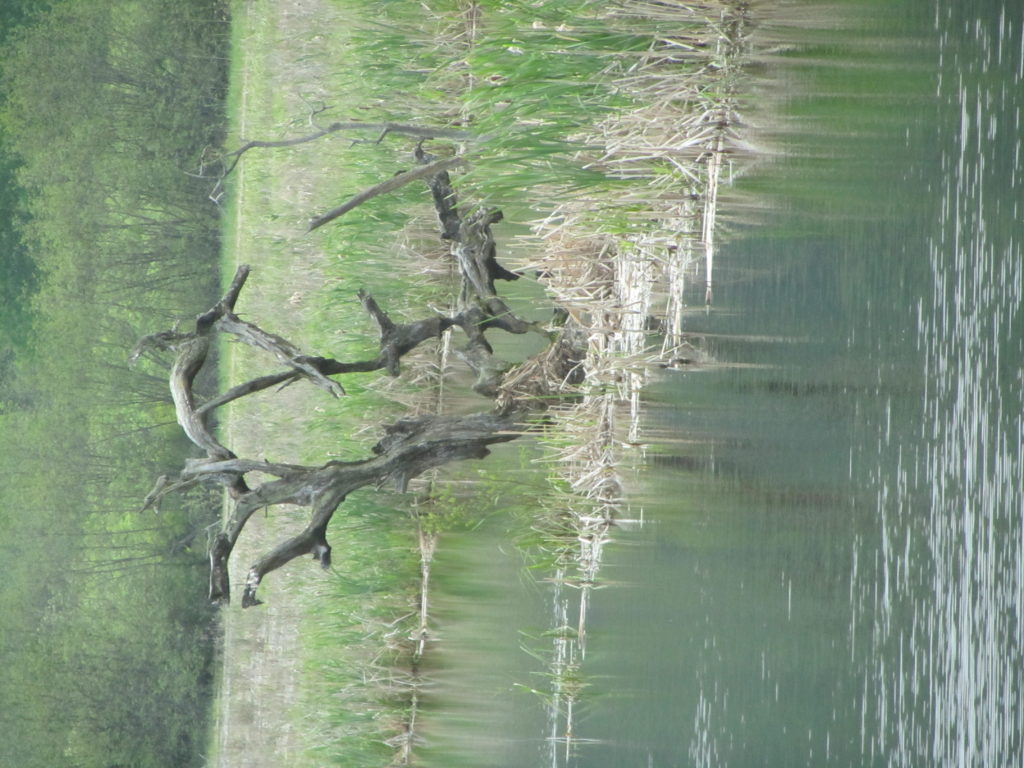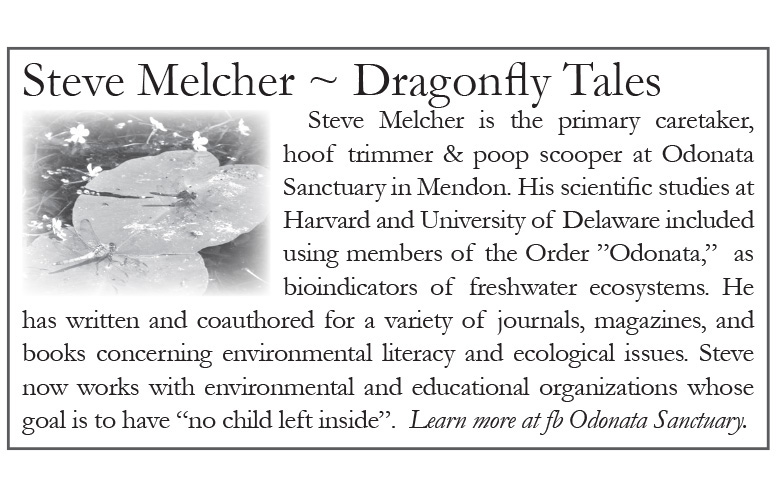Dragonfly Tales-Vitamin N
- By Steve Melcher –

The Essentials:
That’s not just dirt under my fingernails.
Folks who think I’m a vegan often ask, “Where do you get your protein?” I answer “I eat plenty of whofoplaba.” You can be a vegan and eat Oreos, chips and drink beer. Well, not the old Guinness that formerly used isinglass, a collagen harvested from fish swim bladders used to filter impurities out of the brew. The new Guinness contains and uses no animal products. As a vegan, you have to be conscious that some beers have whey or milk products and some wines use egg whites in their precipitation process. But that’s another article. I tell them that by eating whofoplaba, I get plenty of protein. “Where can I get some whofoplaba?”, they ask. I answer by quoting Michael Pollan, “Eat food, not too much, mostly plants,” and adds, “and stay away from processed foods”. Then I am told that you can’t make muscle without meat. I refer them to the current medical literature, the movie Game changers and show them a photo of a silverback gorilla who builds some pretty impressive muscles from eating just leaves. And then I’ll ask, “Where do you get your fiber?” Meat packs more protein per ounce than veggies but also has zero fiber. Check out any floor of the hospital and you won’t find the protein deficiency ward, but you will find plenty of illnesses related to a lack of fiber and poor diet. They may also ask where I get my Vitamin B12. This is a good question for all of us and the answer is interesting. B12 is produced by bacteria found in soil as well as in the guts of animals including humans. The cow you ate didn’t make Vitamin B12, that future burger got it from eating plants. Humans used to get plenty of Vitamin B12 from plants, nuts and tubers that were covered with dirt. In that dirt were Vitamin B12 producing bacteria. “You’ll eat a peck of dirt before you die,” is the old proverb but hardly seems applicable as we shop for sterilized and hermetically sealed vegetables. So, I buy locally grown veggies and take a Vitamin B12 supplement.
“Essential” in medical terms means that we cannot produce it ourselves. We need Vitamins D and B12 but cannot produce them ourselves. We get Vitamin D from the sun and B12 from bacteria. I won’t go into the value of a plant-based diet. Many of you are on that journey already and I may share my thoughts in the future. Those of you who have done some reading and research may have become familiar with our own local version of promoting a whole food plant-based diet: Rochester Lifestyle Medicine. Physicians can now become board certified in Lifestyle Medicine. The American Board of Lifestyle Medicine (ABLM) certification is recognized by the American Board of Medical Specialties. One such Doc, a local radiologist, is Ted Barnett who is referred to as the ‘High Tech Doc with Low Tech Solutions’. Ted and his group at the Rochester Lifestyle Medicine Institute run several workshops and courses with the goal of introducing folks to a whole foods plant based diet and the value of ‘green exercise’. Part of a healthy lifestyle is pretty much what your mom told you when you were a kid: eat your veggies and go outside and play. America is slowly making headway with transitioning to a plant based diet. The realization that Type 2 diabetes and childhood obesity are food-borne illnesses are persuading concerned parents to be more conscious of what their kids are eating at home and at school and steering them away from the local junk food eateries. Adults diagnosed with heart disease are more and more opting for cutting up their own carrots instead of having their chest cut open. So I’ll leave what is on your plate to your discretion but I want to discuss another essential part of anyone’s diet.
Another “Essential Vitamin” that we are producing here at Odonata Sanctuary is one that is found in sunshine, soil, plants and animals, mud and butterflies. My question to you is, “Where do you get your Vitamin N?” Vitamin N is a term used in early Nature Study literature over 100 years ago. Recently it has become popularized through the writings of Richard Louv whose book, Last Child in the Woods urges parents to encourage their kids to spend more time in nature. Last Child in the Woods brought together the growing body of research that indicates a direct exposure to nature is essential to a healthy childhood and a lack of exposure will lead to health issues in adulthood. A lack of Vitamin N produces what Louv calls a “Nature-Deficit Disorder” and believes that more exposure to nature would cure many of society’s ailments.
__________________________
If a child is to keep his inborn sense of wonder, he needs the companionship of at least one adult who can share it, rediscovering with him the joy, excitement, and mystery of the world we live in. Rachel Carson

Modern humans have become disconnected from nature through our daily activities and this disconnect has had negative consequences in terms of mental and physical health. Proof of this hypothesis lies in studies that show how people with ailments, such as ADHD, anxiety or depression feel better when they spend quality time in nature.
We cannot produce our own Vitamin N but we are fortunate to live in the Finger Lakes of New York where the stuff literally grows on trees. We just have to decide to get ‘out of doors’ to be exposed to Vitamin N. You can literally step “out of your door” here and become bathed in a forest of phytocines.
Docs have been encouraging folks to attend “retreats” for hundreds of years. In the Han dynasty, physicians encouraged outdoor “frolicking exercises” to ward off aging. Hippocrates called walking “man’s best medicine.” Tuberculosis patients were sent to mountain retreats and spas here in New York to take in the “magic airs.” Today in Japan, “Forest Bathing” has become popular. Shinrin-yoku (forest-bathing), is being prescribed for uptight, stressed out employees of Mitsubishi, Toyota and Honda who are suffering from “digital toxicity.”
Humans are intimately connected to the earth. This connection is described in E.O. Wilson’s book: Biophilia. Ed notes that we thrive when we are surrounded by other life forms and nature in general. This is why we prefer green scenery and may be why we are so obsessed with kitty videos. Psychologists have now developed multiple scales to determine how connected a person is to nature, and how we might be able to increase our connection to our benefit. Connection to nature research is still developing, but early results seem to indicate that how connected to nature you are is related to your environmental behaviors, such as participation in recycling programs and an increase in overall wellness and happiness.
Organized Grime: Let’s Talk dirty.
Join the Scouts! Hit the Trail!
Find a Nature Club
or Create One!
We may not agree on how we get our amino acids and essential vitamins but we do agree that without them we could not sustain our good health. Let’s talk about ways that you can get some good, old, maybe not so clean, Vitamin N. The American Nature Study Society, which is our oldest environmental education organization, has reams of activities that encourage children and their families to explore nature. These are available online, in journals and books and through the archives of Cornell University. The new school of Nature Study is represented by CCN: Children & Nature Network. Based in North America, the Children & Nature Network has summarized research from academic institutions around the world that indicate a disconnect from nature is a real phenomenon. The world has become concerned about the health of our children. In 2012 the IUCN (International Union for the Conservation of Nature) adopted the resolution that concerns, “A Child’s Right to Connect with Nature and to a Healthy Environment”. Medically, pediatricians are getting involved with programs like SHINE, (Stay Healthy in Nature Everyday). Physicians are now legally able to prescribe a trip to the park or a walk in the woods. Your pediatrician may write out a script to: “Spend at least 3 hours every month volunteering at Odonata Sanctuary. Refill as needed.” You could insist your kids get outside at school when possible and help create and fund a school garden.
Get out in the natural world. Walk, hike, run, cycle, or saunter. A healthy lifestyle is one that comprises a diet of primarily plants with the least possible processing, and a rich association with nature. This will lead to nurturing more positive social and emotional connections with friends, family, juntas, packs and tribes. These interrelationships are becoming more essential now than at any time in the Anthropocene epoch.
We are very fortunate to live in a rural setting where we are close enough to hear an orchestra play Wagner as well as explore some of America’s finest wild areas. I want to put in a plug for our local farmers and how much they need our support. By supporting your local farmer, you enable her to pay those ever rising taxes. Imagine if we could pay a farmer, through tax abatements, not to plant corn or soybeans on a few acres. These grains are usually sold for feed to animals trapped in CAFOs (Confined Animal Feeding Operations) somewhere out in the Midwest. Those fields could be growing local foods or providing some Vitamin N for the neighborhood. There were federal programs that actually did incentivize farmers to restore wetlands and ground nesting bird habitat and allow fields to return to forests. The funds for these programs are no longer available, but we can decide in what kind of environment our kids grow up. We can decide there is value in a life rich in nature experiences and resolve to preserve those places through land trusts and tax incentives. We can decide to protect our precious source of the essential nutrient: Vitamin N.
Further Research: Books, Movies and Definitions
•Whofoplaba: Whole Foods Plant Based diet. Beware of side effects: may cause increased energy, lower cholesterol, improved skin condition, improved digestive health, improved BMI, lower blood pressure, reduced risk of heart disease, longer life expectancy. On a world influence basis: less Greenhouse gas emissions, reduced deforestation, more water saved, help with global supply, and reduced antibiotic misuse.
•Phytocines: natural aromatics that plants produce, which, when inhaled, stimulate the immune response. •Anthropocene Epoch: is an unofficial unit of geologic time, used to describe the most recent period in Earth’s history when human activity started to have a significant impact on the planet’s climate and ecosystems. •Game Changers: movie about plant based athletes. •Handbook of Nature Study by Anna Botsford Comstock•Last Child in the Woods: Saving Our Children from Nature-Deficit Disorder by Richard Louv •In Defense of Food: An Eater’s Manifesto by Michael Pollan•Google “Ecotherapy.”
